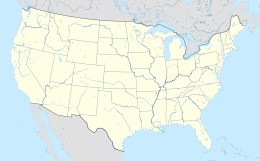Richard Nixon Presidential Library and Museum
 |
|

View from birthplace looking across gardens to the Nixon Library Museum
|
|
| Location |
33°53′21″N 117°49′10″W / 33.88917°N 117.81944°WCoordinates: 33°53′21″N 117°49′10″W / 33.88917°N 117.81944°W Yorba Linda, California, United States |
|---|---|
| Dedicated | July 19, 1990 |
| Rededicated | July 11, 2007 |
| Named for | Richard Nixon |
| Size | 52,000 sq ft (4,800 m2) |
| Management |
National Archives Richard Nixon Foundation |
| Website |
nixon nixonfoundation |
The Richard Nixon Presidential Library and Museum is the presidential library and final resting place of Richard Milhous Nixon, the 37th President of the United States (1969–1974), and his wife Pat Nixon. Located in Yorba Linda, California, the library is one of 13 administered by the National Archives and Records Administration (NARA). From its original dedication in 1990 until becoming a federal facility on July 11, 2007, the library and museum was operated by the private Richard Nixon Foundation and was known as the Richard Nixon Library & Birthplace. The 9-acre (3.6 ha) campus is located at 18001 Yorba Linda Boulevard in Yorba Linda and incorporates the Richard Nixon Birthplace, a National Historic Landmark where Nixon was born in 1913 and spent his childhood. The facility is now jointly operated by NARA and the Richard Nixon Foundation.
Historically, all presidential papers were considered the personal property of the president. Some took them at the end of their terms while others destroyed them. Franklin D. Roosevelt was the first to make them available to the public when he donated them to the National Archives in 1939, as the Franklin D. Roosevelt Presidential Library and Museum, but did so voluntarily. The Watergate scandal and Richard Nixon's subsequent resignation from office complicated the issue, however.
In September 1974, Richard Nixon made an agreement with the head of the General Services Administration, Arthur F. Sampson, to turn over most materials from his presidency, including tape recordings of conversations he had made in the White House; however, the recordings were to be destroyed after September 1, 1979, if directed by Nixon or by September 1, 1984, or his death otherwise. Alarmed that Nixon's tapes may be lost, Congress abrogated the Nixon–Sampson Agreement by passing the Presidential Recordings and Materials Preservation Act, which was signed into law by President Gerald Ford in December 1974. It applied specifically to materials from the Nixon presidency, directing NARA to take ownership of the materials and process them as quickly as possible. Private materials were to be returned to Nixon.
...
Wikipedia


